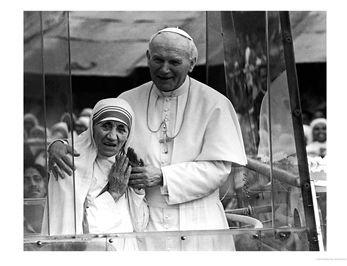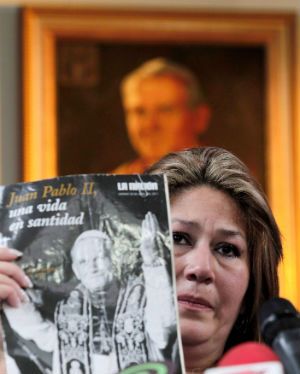
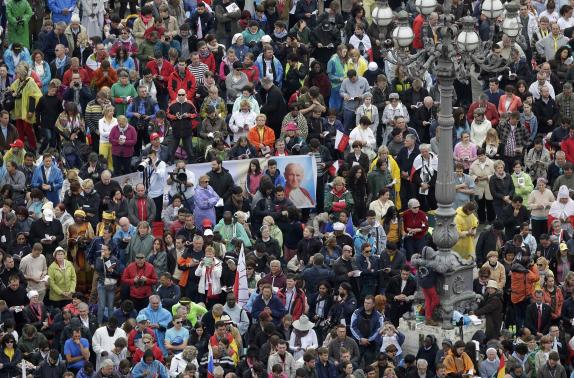

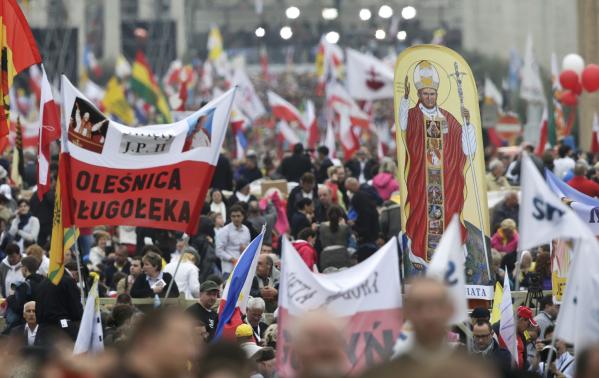

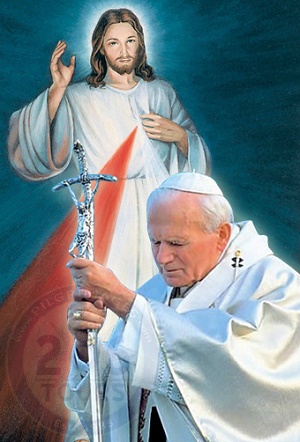
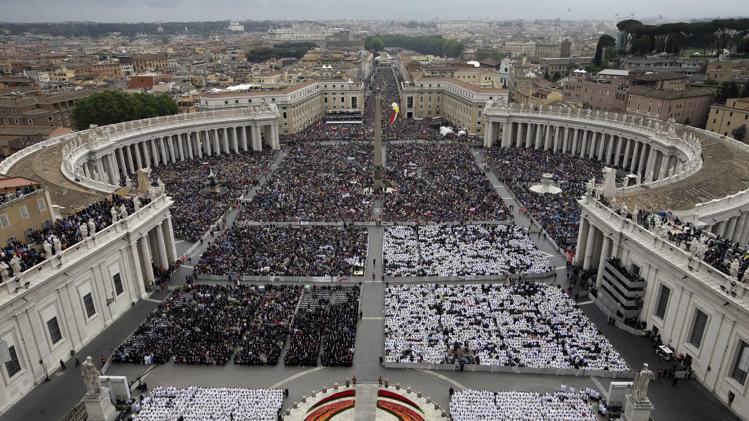
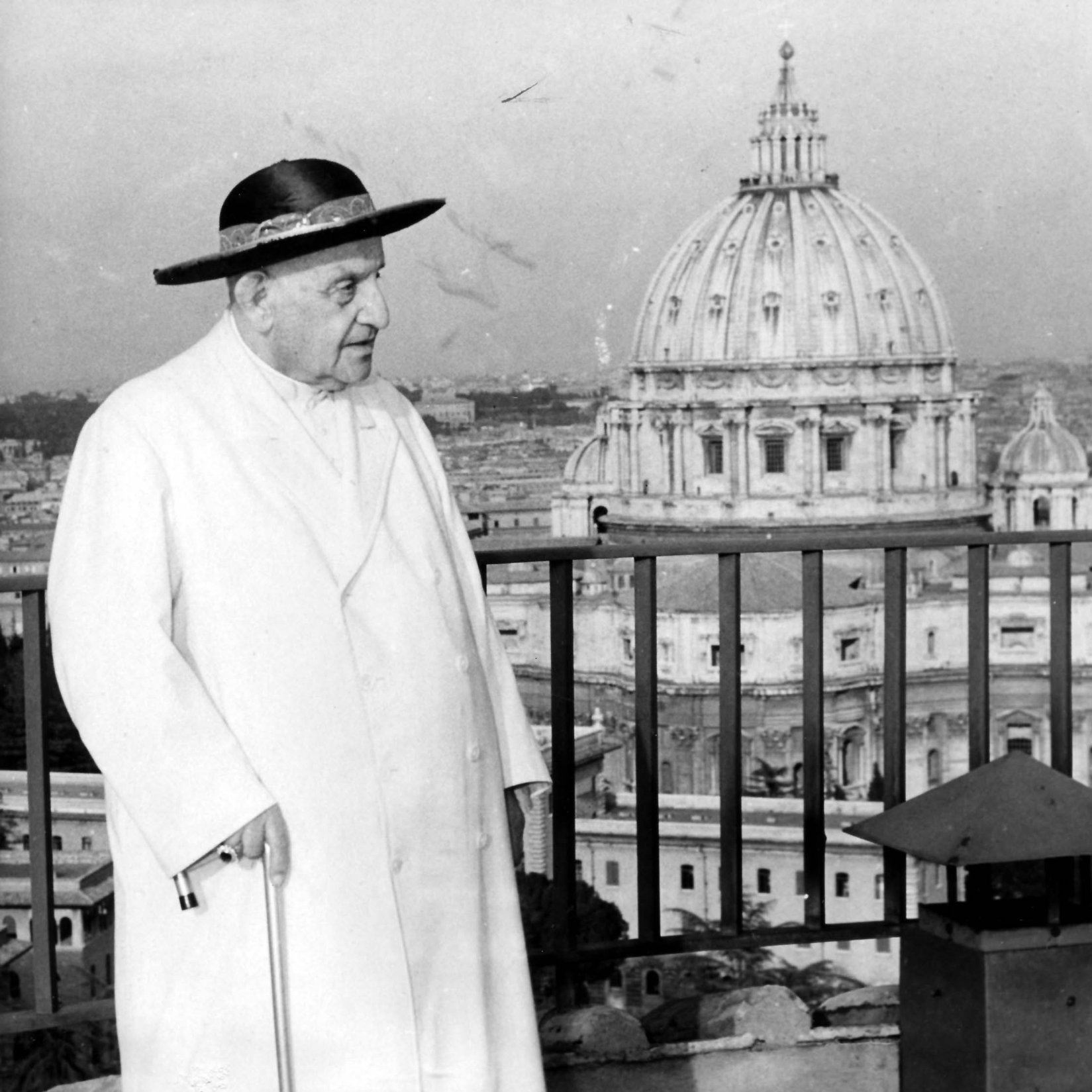

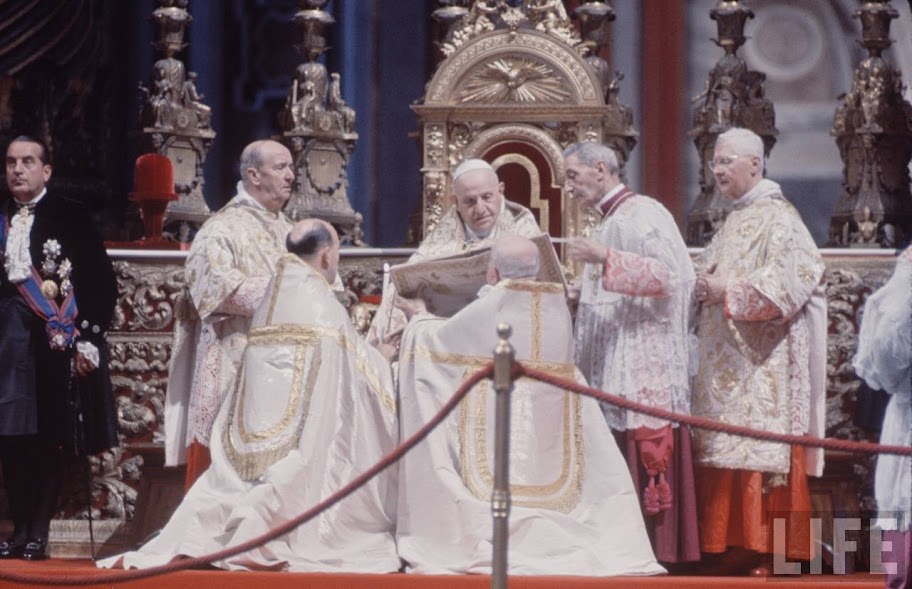
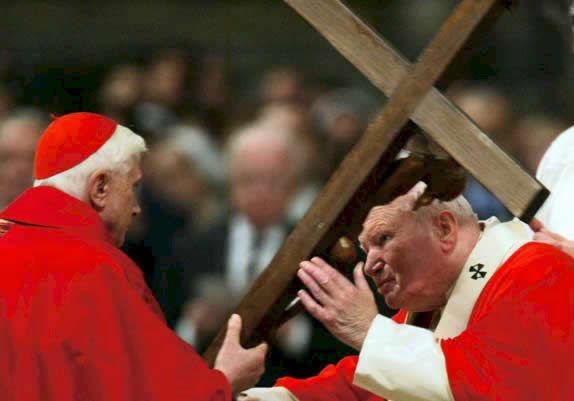
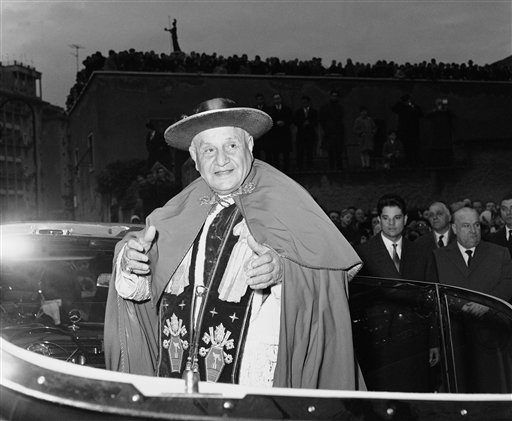
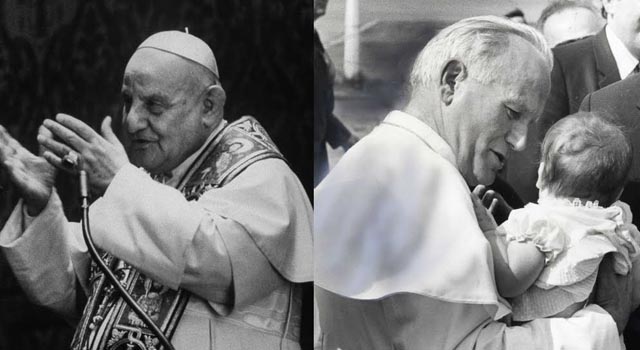
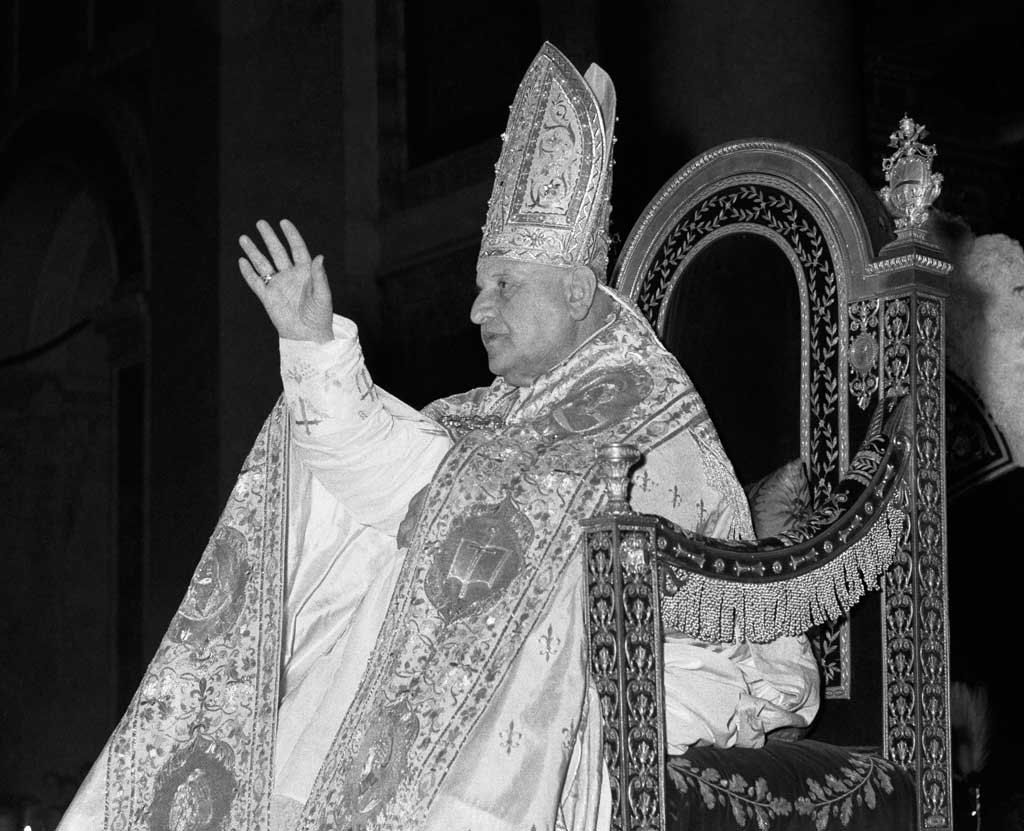
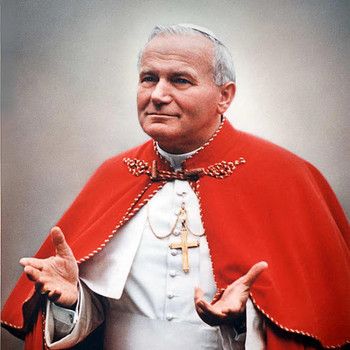
VATICAN CITY – Pope Francis declared Popes John XXIII and John Paul II saints before over 1 Million people on Sunday in an unprecedented ceremony made even more historic by the presence of emeritus Pope Benedict XVI in St. Peter's Square. Never before have a reigning pope and a retired pope celebrated Mass together in public, much less at an event honoring two of their most famous predecessors.
Benedict's presence was a reflection of the balancing act that Francis envisioned when he decided to canonize John and John Paul together, showing the unity of the Catholic Church by honoring popes beloved by conservatives and progressives alike. Francis made that point clear in his homily, praising both new saints for their work associated with the Second Vatican Council, the groundbreaking meetings that brought the 2,000-year-old institution into modern times. John convened the council in 1962 while John Paul helped ensure its more conservative implementation and interpretation.
"John XXIII and John Paul II cooperated with the Holy Spirit in renewing and updating the church in keeping with her pristine features, those features which the saints have given her throughout the centuries," Francis said. He praised John for having allowed himself to be led by God to call the council, and he hailed John Paul's focus on the family -- an issue Francis has taken up himself.
"They were priests, bishops and popes of the 20th century," Francis said. "They lived through the tragic events of that century, but they were not overwhelmed by them." It was Benedict who put John Paul on the fast-track for possible sainthood just weeks after he died in 2005, responding to the chants of "Santo Subito!" or "Sainthood Now!" that erupted during his funeral Mass. His canonization is now the fastest in modern times. A lot has been made of the contrasts between the two Pontiffs. John the XXIII is known as having been a great liberalizing force for the Catholic Church, and John Paul II a real advocate for adhering to its most conservative tenets. But many church insiders say actually the two men represent continuity in the Church. John XXIII made it more accessible to people by replacing Latin masses with vernacular ones, and having priests face the congregations rather than stand with their backs to them. And John Paul II, with his tireless globetrotting, brought the Church to the people. And he did it for more than a century. You can see the impact of that when you assess the crowds on St. Peter's Square who have come from around the world to celebrate these canonizations. Father Thomas Rosica of the Holy See Press Office noted, "What is amazing about this unique relationship of John Paul II and young people is the older he got and the more infirm he became, the more significant he was for young people. One would think that young people would only look tothose that are agile and beautiful and standing tall, athletes and stars that the world offers us." The Church in recognizing saints - there are many unrecognized, uncanonized saints - affirms that our Communion of Saints extends into heaven, creating a between the saints in heaven, the souls in purgatory, the angels, and the faithful on earth. The message here is a simple one: we are not on our own, ever - the virtue of supernatural charity is not a mean, but an excess.
WASHINGTON,DC (Catholic Online) - There are between 10,000 and 11,000 saints canonized by the Catholic Church, depending on the sources you include. Pope Francis added 813 saints to the list on one day, May 13, 2013, and now we are to celebrate the recognition of two more, Pope John XXIII and John Paul II on April 27 in St. Peters Square. Attendance estimates start at 500,000 and go as high as a million.
Such a gathering of the faithful from around the world in this age of secularism and the myriad of books pouring out on the New Atheism! What would happen if a leading atheist, say Richard Dawkins, died and one of his acolytes organized an event to memorialize Dawkins and announce him the athiest's version of a saint. I'm not sure what that would be called - perhaps, the first Refuser.
I can imagine the New Atheists memorial being held in Washington Square, with about 300-400 people in attendance, mostly curious NYU students and chess players. "Richard Dawkins denied the existence of God to the very end of his life, without any hesitation or qualification". Richard Dawkins would be eulogized for refusing to accept the solace of eternal life even in the face of death. Presumably dozens of those present with well-thumbed copies of Nietzsche in the back packs would nod in appreciation. We know that St. Peter's Square will be overflowing with happy faces, banners waving, and spontaneous outburst of songs - in many languages - who will greet the arrival and presence of Pope Francis. What would the mood be like in Washington Square at the memorial service of the world's best known "militant atheist"? There aren't any songs that come to mind, though atheists themselves are partial to quite a few songs, including "Letting Go of God" sung by Julia Sweeney. Click read more for pictures
We can bet that Washington Square would be filled to the brim with media - reporters reporting live, TV cameras streaming the events, and inter-views with attendees. The number of the media would very likely equal the number of attendees, to the point that each attendee would have his or her own personal media partner. Even the thousands in the annual March for Life compete for media coverage with a dozen pro-choicers, shouting, sign waving, and looking angry. Being an a-theist, that is, without God, is problematic when determining just what you are for. The word itself begins with a prefix that denies and negates what follows, God. An atheist is always, therefore, opposed to the-ism, belief in God. The celebration of Richard Dawkins at the first Refuser would be a celebration of absence, of a belief that is missing, missing because Dawkins consistently rejected it. Not really the occasion for singing or dancing, or outbursts of joy over the life he lived. One aspect of the Church's canonization, however, would be the same as Dawkins being recognized as the first, presumably, in an ongoing list of Deniers and Refusers. Canonization derives from a Greek word meant to set a standard. Richard Dawkins would become the model for deniers to follow, but since the afterlife is missing Dawkins would not be able to offer any help from beyond the grave. The totality of the Dawkins' legacy would consist of his books, videos, audiotapes, letters, paper, and memories of those who knew him. Though none of Richard Dawkins colleagues, admirers, and disciples will be praying for his soul, I am certain there are many who will. Who knows? The day may come when Dawkins will intercede on behalf of the New Atheists, that all of them will drop the "a" from their atheism. Anything can happen, and often does.
Catholic saints are considered more than models of spirituality -they can intercede for us, which is why a miracle is required for beatification, a miracle that occurs after the saint's death. An authentic miracle provides evidence of the saint's ability to intercede from heaven for a person in need. A second miracle is normally required before the Church announces canonization, but Pope Francis made an exception in the case of Pope John XXIII. The Church in recognizing saints - there are many unrecognized, uncanonized saints - affirms that our Communion of Saints extends into heaven, creating a between the saints in heaven, the souls in purgatory, the angels, and the faithful on earth. The message here is a simple one: we are not on our own, ever - the virtue of supernatural charity is not a mean, but an excess. Not only will your neighbor pray for you in your time of need but also those you never knew, saints who died centuries ago fill the heavens with nothing but time on their hands, so to speak, to hear your prayers and intercede with God the Father on your behalf. No wonder, then, that St. Peters Square on April 27th will be the happiest place on earth, a celebration of the grace pervading the universe. That is why any declaration of Richard Dawkins as the first Refuser may be premature.
© Deal W. Hudson, Ph.D
Deal W. Hudson is president of the Morley Institute of Church and Culture, Senior Editor and Movie Critic at Catholic Online, and former publisher and editor of Crisis Magazine.This column and subsequent contributions are an excerpt from a forthcoming book. Dr. Hudson's new radio show, Church and Culture, is heard on the Ave Maria Radio Network.
Women who experienced miracles that led to canonizations speak out
Floribeth Mora Diaz holds up the magazine that laid beside her on her death bed when she prayed to Pope John Paul for a miracle to cure her brain aneurism.
LOS ANGELES, CA (Catholic Online) - From Costa Rica, Mora was suffering from an aneurism that left her disabled with headaches. Local doctors refused to treat it and doctors in Mexico or Cuba were far too expensive. "The doctors told me there was no sense to continue treatment because they had done everything and there was not much more we could do," Mora told a packed news conference. "They said I only had one month to live and there was no hope." Advised to pray, John Paul II appeared to Mora in a vision on the day he was beatified, the first step on the road to sainthood, after he was credited with his first miracle.
"I felt a deep sense of healing. I heard his voice say to me, 'Get up and don't be afraid,'" she said, recalling one of John Paul's signature lines.
"I went to my husband in the kitchen and told him I was cured. I realized little by little the illness had been taken away." Doctors conducted tests on her for two weeks in October 2013 in order to confirm the miracle.
The first miracle attributed to John Paul was the apparent healing of a French nun, Sister Marie Simon-Pierre, who recovered from Parkinson's disease with no medical explanation after praying to the late pontiff soon after his death in 2005. Pope Francis had provoked debate within the church by approving John XXIII's sainthood with only one miracle. John was beatified in August 2000, based on what was considered a miraculous healing of an Italian nun, Sister Caterina Capitani, after a medical commission found no scientific explanation for the event. Sister Adele Labianca, caring for Capitani, revealed details of what she called the miracle that saved the nun's life in May 1966 after she had prayed to the pope, who had died three years earlier. Capitani had undergone an operation to remove a cancerous tumor in her stomach but her condition was deteriorating when she suddenly recovered. Labianca said doctors had no medical explanation for what took place. "It was a miracle," said Sister Labianca. "Not only was it a physical healing but an internal healing when you could feel the presence of God."
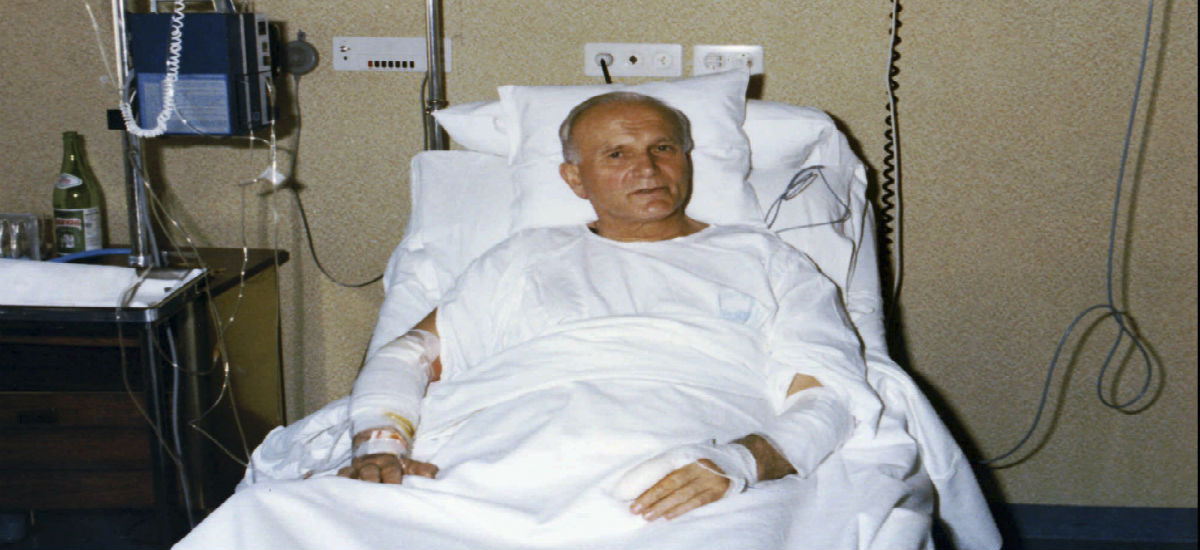
John's Paul II's Doctor: I don't know how he survived the shooting
"I don't know how he survived the shooting," Dr. Rodolfo Proietti told the media. He also explained that doctors also learned a lesson about willpower and intervention, and that Bl. Pope John Paul worked hard, "even after he no longer had a voice."
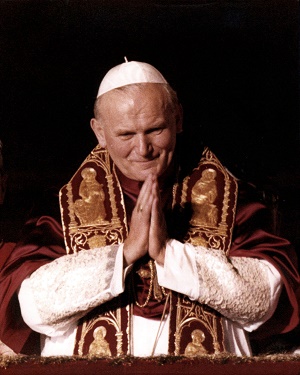
St. John Paul II became a seed of the New Springtime he proclaimed. He joined the Lion of the Tribe of Judah and the Lamb who was slain for our sins. He is now a light, illuminating the way forward. As the catechism declares so well, The saints have always been the source and origin of renewal in the most difficult moments in the Church's history." Indeed, "holiness is the hidden source and infallible measure of her apostolic activity and missionary zeal.
Lion, Lamb and Light: The Canonization and Living Legacy of St John Paul II
CHESAPEAKE, VA (Catholic Online) - I was not alone on that day. It seemed as though the whole world was joined with me, watching and weeping, as the servant of the servants of God, the polish Pope who began his stunning and historic pontificate as a lion, went home to the Heavenly Father as a lamb. Throughout those years, from October 16, 1978 through April 2, 2005, John Paul II beautifully and prophetically pointed the way to his Savior and the Hope of that world, Jesus Christ. Now, he lives in that communion of love with the great cloud of witnesses to which the author of the New Testament Letter to the Hebrews attests. (Hebrews 12:1-3) From that communion of saints he now reflects the light of Jesus, the Light of the world, for an age which is in need of true liberation.
On March 7, 2014, Pope Emeritus Benedict gave an interview to a Polish Journalist named Wlodzimierz Redzioch, one of the many insightful authors at that excellent magazine entitled Inside the Vatican. Vatican Radio covered the interview here. My friends at Catholic News Agency published lengthy quotes from the Italian daily Corriere della sera, in an insightful article by Elise Harris here. Benedict recounted, with deep affection and sincere love, the influence and impact of St. John Paul II on his own life and ecclesial ministry. The interview is a part of a book entitled Beside JPII: Friends and Collaborators Speak. He affirmed what the faithful declared so strongly in the streets on the day when St. John Paul's Body was processed through the streets of Rome and they cried out Santo Subito. He told Redzioch, "In the years of collaboration with him it became ever more clear to me that John Paul II was a saint." In the discussion pertaining to his decision to advance the cause of St John Paul's beatification earlier than the standard process, Benedict noted that he did so because he was convinced of his holiness. He spoke of John Paul's "intense relationship with God." That was obvious to those with the eyes to see. St. John Paul embodied the cry of the Apostle Paul, -it is no longer I who live, but Christ who lives in me; and the life I now live in the flesh I live by faith in the Son of God, who loved me and gave himself for me. (Gal. 2:20)
The Catechism of the Catholic Church explains that - By canonizing some of the faithful, i.e., by solemnly proclaiming that they practiced heroic virtue and lived in fidelity to God's grace, the Church recognizes the power of the Spirit of holiness within her and sustains the hope of believers by proposing the saints to them as models and intercessors. "The saints have always been the source and origin of renewal in the most difficult moments in the Church's history." Indeed, "holiness is the hidden source and infallible measure of her apostolic activity and missionary zeal. (CCC 828) In another interesting interview with Vatican Radio, back in 2008, Cardinal Jose Saraiva Martins, prefect of the Congregation for the Causes of the Saints, recalled the events which occurred in St. Peter's Square at the funeral of the Servant of God, John Paul II: We remember the shouts of 'Santo subito!' 'Sainthood now!' that phrase, that cry, in St. Peter's Square, expressed what people were thinking. It meant that John Paul II genuinely had a true reputation for holiness among the faithful. And we know that is essential in the process of beatification.
That interview addressed the sense of the faithful that we had, and we have, a Saint in our midst. The Lord knows, we need his example and his prayers during this new missionary age of the Church. Like millions of the faithful throughout the world, I watched and prayed throughout the entire last night for Pope John Paul II. He had shown us all how to live, by choosing daily to be fully given over to Jesus Christ. He had shown us that suffering, joined to the Savior, can become a sign of God's continued mercy and an occasion of grace when joined to the suffering of the Savior, in a total oblation of Love. His witness was beyond words. Then, he showed us how to embrace death, not with fear, but with faith. He knew it was time to go, as he said in Polish, six hours before his death,to his close friend at his bedside, "Let me go to the house of the Father." We were privileged to experience the leadership, in both word and deed, of the successor of Peter, the Vicar of Christ, now known as St. John Paul II. I know that I was not alone in praying for his rapid canonization. In my personal opinion, the process was not only correct, it signals the beginning of a prophetic age of the Church. There is no doubt in my mind that John Paul II singularly influenced me more than any person in my life. I will write more of that influence and, of my meeting him which changed me profoundly, in later articles.
For now, I find it to be telling that all these years later, as I have agedd and seem to be forgetting much, I still I vividly remember that day in October of 1978, when he stepped out on to the balcony in St. Peters Square and proclaimed: "Be Not Afraid! Open up, no; swing wide the gates to Christ. Open up to his saving power the confines of the State, open up economic and political systems, the vast empires of culture, civilization and development.. Be not afraid!" Affirmed by many as one of the chief architects of the Second Vatican Council and its document on the relationship of the Church to the modern world" (entitled "Joy and Hope" or "Gaudium et Spes" in Latin), this strong, passionate, charismatic priest and Bishop occupied the chair of Peter with a grace and dignity which pointed all who encountered him to the Lord whom he served. At a critical time in the history of both the Church and the modern world, he stepped forward like a lion, with a prophetic roar. He strode onto that platform with strength and vitality and the whole world seemed to know that God was doing something spectacular.
This mountain climbing Polish Pope was so filled with the love of God that it was contagious. A talented and gifted "man of letters", a playwright, a philosopher, an intellectual giant, a poet, but more importantly, he was a genuine human being with a big heart that embraced the whole world, like the Heart of the One whom he represented so beautifully as Vicar on earth, the King of Kings, Jesus the Lord. Like a lion in Peter's chair, he consistently and tirelessly lived what he proclaimed with great courage. Unafraid, he traversed the globe, proclaiming freedom to the captives and truth to the victims of failed false ideologies that had ravaged the people of the twentieth century, the bloodiest in all of human history. He never stopped passionately re-presenting the classical, unchanging, Christian message with a prophetic urgency, profound clarity and contemporary relevance. Communism, atheism, secularism, false humanisms . were all exposed in their empty promises. The horrors that they had unleashed with their false utopian claims were exposed as well. St. John Paul II proclaimed that the "Redeemer of Man" (the title of his first encyclical letter), Jesus Christ, was the path to authentic personal, social and universal freedom!
He authored more encyclical letters, apostolic exhortations, constitutions and letters than any Pope in the two thousand year history of the Christian Church. In those he developed rich themes during his service to the Church and the world, which are still being unpacked. He had a gift of using pregnant phrases which are still being birthed. They all offered great potential for renewal. Phrases such as; Culture of Life, Civilization of Love, New Evangelization, New Springtime of world missions, Universal Call to holiness; Christian Marriage and family life as a domestic church; Spirituality of Communion; Theology of the Body; The Common Good; Unity of Life; New Humanism; New feminism and the Feminine Genius; Two Lungs of East and West; New Catholic Action", theological anthropology of the gift, and a New Advent for all of humanity in Jesus Christ.
His teaching provided a blueprint for the rebuilding of the Church in our day, so that she could rise to the great missionary moment of the Third Millennium of Christianity. This mission and message was skillfully and brilliantly developed into a body of rich theology by his humble friend and successor, Pope Emeritus Benedict XVI. Then, after his fruitful years of service and historic, humble choice to step down from his office for the sake of the ongoing work of the Church, it is being stepped into prophetic action by Pope Francis. We are living in a trajectory of the Holy Spirit at the helm of the Church.
St. John Paul II insisted that no area of human experience is off-limits to the influence of the Gospel and the Church. The Church is, in the words of the Fathers of the second Vatican Council, an "expert in humanity". He was a profoundly evangelical Pope, calling all men and women to encounter the Evangel, the Good News - the Risen Jesus Christ. He called all men and women to that One Redeemer, Jesus Christ. In Him they were invited - they are invited - to discover the purpose and fulfillment of human life itself. He proclaimed the truth that human existence is an invitation to communion with God and with one another. He spoke a message to an age bent of "self fulfillment" that we can only find our human fulfillment in giving ourselves away in love, to God and to one another, as a gift.
He called all of us to live a dynamically alive, fully integrated Christian faith and lifestyle, exhibiting what he called a "unity of life". In other words, making sure that we walked the talk, that the implications of the Christian faith inform the entirety of our lives - with no contradiction or separation. He confronted and exposed what he labeled the culture of death, wherein the human person is treated as an instrument to be used rather than an unrepeatable gift to be received. He proposed a different way, that of building a new culture of life where every human person, at every age and stage, is recognized as having an inviolable dignity and right to life, freedom and love. He spoke constantly of building a Civilization of Love. He prophetically called us to be about the task, through both the power of his words and the witness of his life.
He charted a path to authentic peace and solidarity, proclaiming to the Nations that we are our brothers' keeper and that we owe an obligation in solidarity to one another and, most especially, to the poor in all of their manifestations in our midst. He insisted that authentic human freedom is a freedom for and not just a freedom from. What we choose truly matters. It not only changes the world around us, but changes us. He reminded us regularly of the essence of the moral teaching of both the Natural Law and revelation that the exercise of human freedom must always be directed toward chossing the true, the good and the beautiful. He exposed what he called a counterfeit notion of freedom, such as when freedom is wrongly directed and uses persons as property. He was properly called a Master of the Social Teaching of the Catholic Church. In fact, the Compendium of the Social Doctrine of the Church is dedicated to him, under that title.
He decried a false notion of the autonomy of the individual. In fact, he warned that it was setting us on a path to a new slavery. He insisted instead that the Christian vision of the human person as made for communion and self-gift in love was the only path to true freedom. He proclaimed that human flourishing and happiness can only found in this rediscovery of our call to communion with God and, in Him, with one another. His writings, allocutions and witness of life - all proclaimed a new and true humanism, a rediscovery of the essential and existential truth that we were created in the Image of God, made for communion, and that we can only become fully human when we live that communion out in love. He insisted that the treasury of the Social doctrine of the Catholic Church was intended for the whole world. That it offered principles which could help build truly just and peaceful societies which promoted the common good. He believed that these principles, if applied in public policy, would lead to just national and international relations. He was correct. The problem is that Catholic Social teaching still largely remains both unread and untried. His writings, in continuity with the Tradition and continued in the wisdom of his successors Benedict and Francis provide the tools we need to build this new culture of life and this civilization of love.
I believe that Saint John Paul II was a Prophet. From his first encyclical letter "The Redeemer of Man" to his last, he eloquently proclaimed that Truth is, as he wrote in one of his finest Moral encyclicals, a splendor. He was also an apostle of Christian unity, a task continued through the work and witness of his successors, Benedict and Francis. He called for reconciliation and healing among separated Christians and, in one of his boldest encyclical letters, "May They Be One", he offered a path to a new model of communion that Pope Emeritus Benedict built upon and Pope Francis is demonstrating - with prophetic power and extraordinary promise.
With deep love, respect and dedication for what he called the Light of the East, St John Paul II called for Eastern and Western Christianity to rediscover their absolute dependence upon one another in order that the entire Body of Christ might rise up and once again breathe with two lungs in order to present the whole Jesus Christ to a world that needs to be liberated. The transformational themes of the pontificate of St. John Paul II still pave the path for the continued renewal of the Church, and through her, for the transformation of human culture. The oft-repeated paragraph 22 from "Joy and Hope", of the Second Vatican Council - which many sources affirm that he authored - is a key to understanding his profound thought, deep faith and hope: In reality, it is only in the mystery of the word made flesh that the mystery of man truly becomes clear. For Adam, was a type of him who was to come, Christ the lord, Christ the new Adam, in the very revelation of the mystery of the Father and of His love, fully reveals man to himself and brings to light his most high calling.
Our Christian faith does not just speak only to our personal lives. It is not private. It speaks to the whole of life and is meant to inform and transform the entire way we both view and live our lives in the real world. It is also profoundly public, to be lived in our lives as an integrated whole, for that world. God still loves the world and He still sends His Son into it, through the lives of those who bear the name Christian. St. John Paul II showed us the way. He began his pontificate like a Lion roaring. He ended it as a Lamb given over to embracing death with love. His influence now continues as a light for the Third Christian millennium. That once vibrant, strong Pope became frail, sick and physically weak before the eyes of the whole world which had greeted him. Then, like the grain of wheat of which the Lord Jesus spoke (John 12:24), he fell to the ground and died. The giant of a man who had once climbed mountains, symbolically mounted the cross of human suffering and, in his frail frame, exercised the authority of his office from the Chair of Peter, a wheel chair. How fitting it seemed to me at the time that the champion of the weak, the disabled, the elderly, those who had no voice, was joined physically to them in order to show the world the truth of the beauty and dignity of every human life! He incarnated the love of God and demonstrated in his life the truth of the claims of the Christian faith. He emptied himself out for the Lord and His people. He then showed us the beauty of a suffering endured in love and offered for others, in the suffering of Jesus Christ.
With decreasing verbal eloquence, because his lips stammered from the ravages of Parkinson's disease, this amazing orator, achieved something beyond words; he demonstrated the truth of the Christian message of love by revealing the God who came to suffer for us all. His prophetic presence through those final hours was shown to the whole world. He invited us all to give ourselves away in love, even in his final beautiful silence. St. John Paul II became a seed of the New Springtime he proclaimed. He joined the Lion of the Tribe of Judah and the Lamb who was slain for our sins. He is now a light, illuminating the way forward. As the catechism declares so well, The saints have always been the source and origin of renewal in the most difficult moments in the Church's history." Indeed, "holiness is the hidden source and infallible measure of her apostolic activity and missionary zeal.
St. John Paul II, pray for us. St. John Paul II, pray for the whole Church. St. John Paul II, pray for the world.
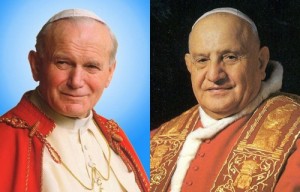
The Diocese of Rome has launched a special website for the upcoming canonizations of John Paul II and John XXIII.
The site www.2PapiSanti.org offers biographies of the two Popes and explains why they will be recognized as saints after the April 27 canonization Mass – which will be broadcast live on the website.
The website provides news about the canonization and related events. The site provides special prayers to John Paul II and John XXIII.
“O Saint John Paul, from Heaven’s window, where we see you alongside Mary, make the blessing of God come down upon us,” the prayer to the Polish Pope reads.
The prayer to John XXIII says in part: “Obtain for us the wisdom of heart to love everyone as our brothers and sisters, to forgive and embrace the erring, to foster that which breaks down the barriers of misunderstanding among people and nations, to suppress our own selfishness, and to generate a fruitful unity of spirit.”
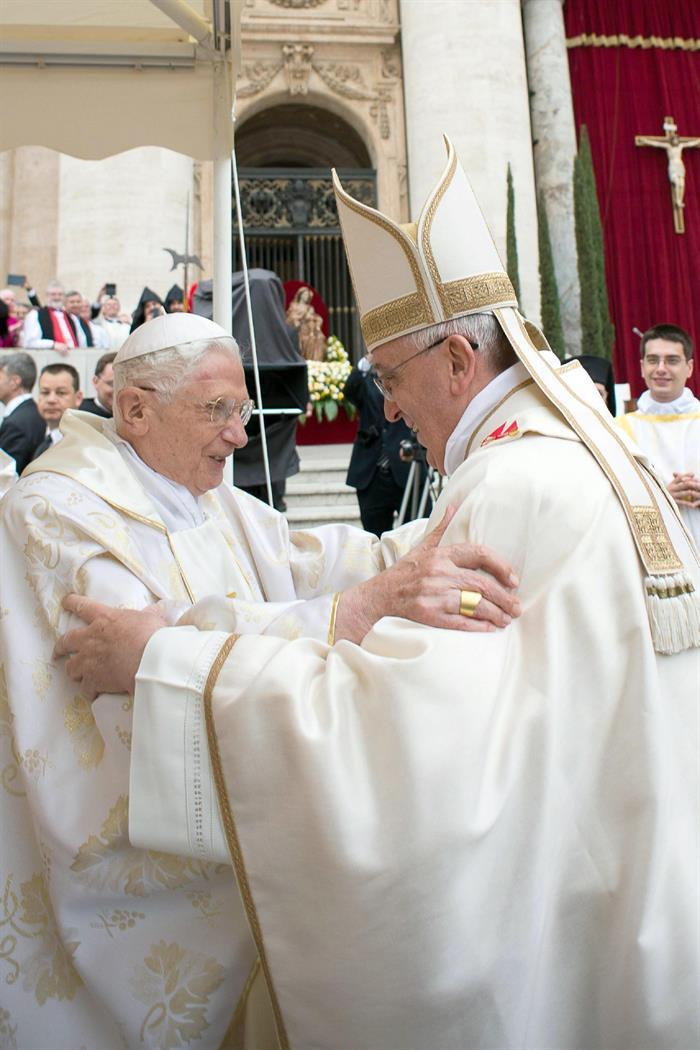
Pope John XXIII Launched Vatican II and Then Some
---
On the night of Oct. 11, 1962, Pope John XXIII did something so natural that it's astonishing it was so revolutionary at the time. He came to the window of the Vatican's Apostolic Palace and spoke to thousands of candle-bearing faithful below — not in the arcane, scripted words of pontiffs past but in those of a father and pastor looking out for his flock.
"Going home, you will find your children. Give them a caress and tell them 'This is the caress of the pope,'" John said to the torch-lit cheers from St. Peter's Square.
While much of the focus of Sunday's dual canonization will be on the globe-trotting, 26-year papacy of Pope John Paul II and his near-record sprint to sainthood, many older Catholics will be celebrating the short but historic pontificate of the "Good Pope," John XXIII.
John's words, delivered on the opening night of the Second Vatican Council, came to define his papacy. The speech epitomized how John captured the hearts of Catholics with his simple, paternal affection while using his intuitive cunning to launch Vatican II and bring the 2,000-year institution into the modern world. It's a combination embodied by the current pope, Francis.
"He was courageous. A good country priest, with a great sense of humor and great holiness," Francis told reporters last summer when asked about John's attributes. "He was one of the greats."
Born in 1881 to sharecroppers in northern Italy, Angelo Giuseppe Roncalli was elected pope on Oct. 28, 1958, naming himself after his father and in the process correcting the accident of history that was the 15th-century anti-pope John XXIII. During the Western Schism of the early 1400s, John XXIII was one of three men who claimed the papacy at the same time, though he later renounced it.
Elected at age 76, the legitimate Pope John XXIII was expected to be a transitional, relatively uneventful pope following the 19-year reign of the World War II-era Pope Pius XII.
John had other plans. Less than three months after being elected, he announced that he would convene Vatican II, the first ecumenical council in a century. Vatican II went on to allow use of the vernacular rather than Latin for Mass. It called for greater participation of lay faithful in the life of the church and revolutionized Catholic relations with Jews. It also crystalized the divisions between traditionalist, conservative Catholics and the more progressive wing of the church that are still alive today.
None of the faithful who gathered in St. Peter's Square the night it opened knew what was in store, but they were hopeful. John's words seemed to herald something new: They were spontaneous when popes usually spoke in stiff, prepared paragraphs. They were grandfatherly when popes were supposed to sound regal. And perhaps most importantly, they were beamed into living rooms around the world on the relatively new medium of television.
"Up until then, television had been used mostly to represent the splendor of power, both ecclesial and political," said Alberto Melloni, John's biographer who runs the foundation in Bologna where his papers are kept. "His way of speaking off-the-cuff that night broke this scheme of video as a demonstration of power."
The speech is now fondly called the "Speech to the Moon." At the start, John marveled at the size of the crowd below and said it seemed almost as if the moon had come out early just to see the spectacle.
Though John didn't live to see the council through — he died of stomach cancer June 3, 1963 — he is credited with having had the courage to launch the process that has defined the 20th-century Catholic Church, renewing church doctrine for modern times.
The Rev. Robert Wister, a church historian at Seton Hall University, said John's "roly-poly appearance" — often cited in the well-meaning but inaccurate caricature of John as a simpleton — belied a steely diplomat who handled some of the church's toughest assignments before becoming pope.
Roncalli was the Vatican envoy to Turkey during World War II, and is credited with having saved thousands of Jews fleeing Europe by forging their birth certificates. He was then named ambassador to France just after its liberation.
"You don't send the village idiot to deal with Charles de Gaulle," Wister said. "You send a sharp diplomat."
At the same time, John was very much a basic parish priest: His first Christmas as pope, John left the Vatican to visit children at Rome's main children's hospital. The next day, he visited inmates at Rome's main prison. Sundays he devoted to visiting parishes in the capital's peripheries. In all, he "escaped" from the Vatican 152 times during his 4 1/2-year papacy compared to the one spontaneous outing by Pius XII to visit a neighborhood devastated by a wartime bombing raid.
Aside from Vatican II, John is perhaps best known for his last encyclical "Peace on Earth," issued in the aftermath of the Cuban missile crisis which had erupted just three days after Vatican II began. The document elaborated a new type of teaching of the church as promoter of world peace. It was the first encyclical addressed not just to clergy but to "all men of good will" in a sign of John's openness to the world outside the Vatican walls.
"He was a man who was able to transmit peace," Francis told a delegation from John's hometown of Bergamo on the 50th anniversary of his death last June. "He transmitted peace because he had a profoundly peaceful soul."
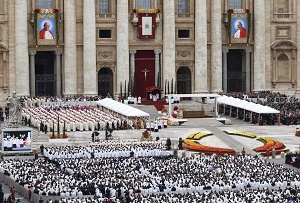
VATICAN CITY (Catholic Online) - Mass of Canonization, 27 April 2014. The Homily of Pope Francis
At the heart of this Sunday, which concludes the Octave of Easter and which John Paul II wished to dedicate to Divine Mercy, are the glorious wounds of the risen Jesus.
He had already shown those wounds when he first appeared to the Apostles on the very evening of that day following the Sabbath, the day of the resurrection. But, as we heard, Thomas was not there that evening, and when the others told him that they had seen the Lord, he replied that unless he himself saw and touched those wounds, he would not believe.
A week later, Jesus appeared once more to the disciples gathered in the Upper Room, and Thomas was present; Jesus turned to him and told him to touch his wounds. Whereupon that man, so straightforward and accustomed to testing everything personally, knelt before Jesus with the words: "My Lord and my God!" (Jn 20:28).
The wounds of Jesus are a scandal, a stumbling block for faith, yet they are also the test of faith. That is why on the body of the risen Christ the wounds never pass away: they remain, for those wounds are the enduring sign of God's love for us. They are essential for believing in God. Not for believing that God exists, but for believing that God is love, mercy and faithfulness. Saint Peter, quoting Isaiah, writes to Christians: "by his wounds you have been healed" (1 Pet 2:24, cf. Is 53:5).
Saint John XXIII and Saint John Paul II were not afraid to look upon the wounds of Jesus, to touch his torn hands and his pierced side. They were not ashamed of the flesh of Christ, they were not scandalized by him, by his cross; they did not despise the flesh of their brother (cf. Is 58:7), because they saw Jesus in every person who suffers and struggles.
These were two men of courage, filled with the parrhesia of the Holy Spirit, and they bore witness before the Church and the world to God's goodness and mercy.
They were priests, bishops and popes of the twentieth century. They lived through the tragic events of that century, but they were not overwhelmed by them. For them, God was more powerful; faith was more powerful - faith in Jesus Christ the Redeemer of man and the Lord of history; the mercy of God, shown by those five wounds, was more powerful; and more powerful too was the closeness of Mary our Mother.
In these two men, who looked upon the wounds of Christ and bore witness to his mercy, there dwelt a living hope and an indescribable and glorious joy (1 Pet 1:3,8). The hope and the joy which the risen Christ bestows on his disciples, the hope and the joy which nothing and no one can take from them. The hope and joy of Easter, forged in the crucible of self-denial, self-emptying, utter identification with sinners, even to the point of disgust at the bitterness of that chalice.
Such were the hope and the joy which these two holy popes had received as a gift from the risen Lord and which they in turn bestowed in abundance upon the People of God, meriting our eternal gratitude.
This hope and this joy were palpable in the earliest community of believers, in Jerusalem, as we read in the Acts of the Apostles (cf. 2:42-47), as we heard in the second reading. It was a community which lived the heart of the Gospel, love and mercy, in simplicity and fraternity.
This is also the image of the Church which the Second Vatican Council set before us. John XXIII and John Paul II cooperated with the Holy Spirit in renewing and updating the Church in keeping with her pristine features, those features which the saints have given her throughout the centuries.
Let us not forget that it is the saints who give direction and growth to the Church. In convening the Council, John XXIII showed an exquisite openness to the Holy Spirit. He let himself be led and he was for the Church a pastor, a servant-leader, led by the Spirit. This was his great service to the Church; he was the pope of openness to the Spirit.
In his own service to the People of God, John Paul II was the pope of the family. He himself once said that he wanted to be remembered as the pope of the family. I am particularly happy to point this out as we are in the process of journeying with families towards the Synod on the family. It is surely a journey which, from his place in heaven, he guides and sustains.
May these two new saints and shepherds of God's people intercede for the Church, so that during this two-year journey toward the Synod she may be open to the Holy Spirit in pastoral service to the family. May both of them teach us not to be scandalized by the wounds of Christ and to enter ever more deeply into the mystery of divine mercy, which always hopes and always forgives, because it always loves.
---
Pope Francis: end world hunger through 'Prayer and Action'
© 2014 - Distributed by THE NEWS CONSORTIUM
Pilgrims fill Roman churches in vigils before canonizations
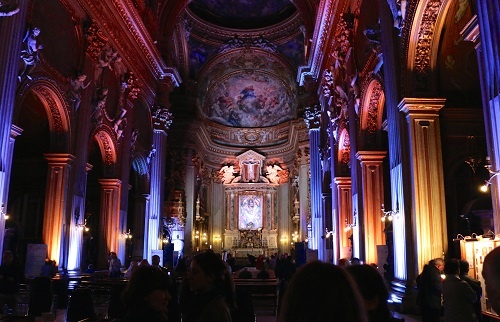
.- Parishes throughout the city of Rome were filled the evening of April 26 with pilgrims spending the night in prayer in anticipation of the next day’s canonization of Popes John Paul II and John XXIII.
More than a dozen churches were open for adoration, Mass, confession, and private prayer, as Catholics from around the world joined locals in the candle-lit parishes, with backpacks and flags by their sides.
One Italian pilgrim, Massimo, attended a vigil with fellow Christians at the church of San Marco in the center of Rome.
“If we are brothers and sisters in Jesus, well, people have the right to see that we love each other. And our mutual love has to be something real, something that they can touch in order to believe,” he told CNA.
He said that he hopes “to share with everybody the experience” of the canonizations, which “has been (a) very nice, very strong experience because they (John Paul II and John XXIII) gave us so much and we, all of us, really can share together, and some beautiful witnesses from them.”
Richard Marsden, a seminarian from England, said that the Popes’ examples of sanctity were an inspiration for his own journey of faith.
“I didn’t meet John Paul II - obviously I saw him on TV and grew up with him as the Pope. It’s amazing to be able to witness somebody become a saint in front of your eyes, because every Christian person is called to be a saint. And to have these examples – like John Paul II, like John XXIII – to try and emulate is a fantastic thing and a great boost to the spiritual life.”
In Piazza Navona, two pilgrim brothers walked across the piazza waving a huge Mexican flag as Polish pilgrims gathered outside the Church of St. Agnes singing hymns. The excitement was evident.
“You see a lot of people from all over the world - it’s just amazing - the other flags from other countries, and you see all the people united in one place,” said Juan Pablo enthusiastically.
His brother, Jesus, who studies and works in Guadalajara City, added, “It’s going to be a huge event. I think that it’s something very important because it’s going to be a saint that we’ve met. I actually met (John Paul II) at the canonization of St. Jose Maria (Escriva).”
Although Juan Pablo never met John Paul II, his mother did - 24 years ago when she was pregnant with her son. “The Pope, gave her a blessing, and that’s why my name is Juan Pablo, John Paul,” he explained.
Pilgrims said the influence and example of John Paul II and John XXIII remain alive in their hearts.
One Polish woman noted John Paul II’s “example of sanctity: human sanctity, simple sanctity… he was the Pope of my whole childhood, so he is an example for me,” she explained.
Giorgio, an Italian man who travelled to Rome from Turin, spoke of John XXIII’s “great courage. He left the Vatican walls and met with people. One rarely sees a Pope like that.”
His fellow Italian Massimo said that the influence of the two Popes is in “what they did and what they lived.”
“It is something that we already have in our hearts, but they gave us a big hand to take it out from our inner selves.”
“What we have to do is to live the mutual love and to give witnesses of this, that is basically the secret of the Trinity, you know, the mutual love. And everybody has the right to share and to live this. Otherwise we are a disaster,” he noted.
“And Pope John Paul II and Pope John XXIII, they showed us how to do it. With young people, but basically with everybody. They made the road, the direction. Now it’s up to us.”
In John Paul's native Poland, bells rang out as soon as Francis pronounced the two men saints.
"He changed Poland and he changed us with his teaching and with his visits here," an emotional Maria Jurek said as she watched the proceedings on giant TV screens at a sanctuary dedicated to John Paul in Krakow.
In the Philippines, where John Paul in 1995 drew the largest ever crowd for a papal Mass at 4 million, Filipinos watched the canonization on TV and joined local celebrations, including a suburban Manila parade of children dressed like the pope.
Yet the atmosphere in St. Peter's seemed somber and subdued -- perhaps due to the chilly gray skies and cumulative lack of sleep of many of the pilgrims who camped out on the streets near the Vatican or stayed up praying at the all-night vigils organized in churches around town. It was a far different scene than the rollicking party atmosphere of John Paul's May 2011 beatification, when bands of young people sang, danced and cheered before, during and after the Mass.
Spirits did pick up after the service when Francis drove through the crowds in his open-topped car all the way down to the Tiber River, giving many people their first -- and only -- close-up glimpse of him.
The Vatican estimated that 800,000 people watched the Mass in Rome, with about 500,000 in the square and nearby streets and the rest watching on TV screens that had been set up in piazzas around town.
By the time the ceremony began, Via della Conciliazione, the main boulevard leading from the square, nearby streets and the bridges across the Tiber were packed.
Polish pilgrims carrying the red and white flags of John Paul's beloved homeland had been among the first to push into the square well before sunrise, as the human chains of neon-vested civil protection workers trying to maintain order finally gave up and let them in.
"Four popes in one ceremony is a fantastic thing to see and to be at, because it is history being written in our sight," marveled one of the visiting Poles, Dawid Halfar.
Benedict had promised to remain "hidden from the world" after resigning last year, but Francis has coaxed him out of retirement and urged him to take part in the public life of the church.
During the Mass, Benedict sat off to the side of the altar with other cardinals, though he was clearly in a place of honor. He received the Italian president and a steady stream of cardinals, as well as Francis himself who embraced Benedict at the beginning and end of the service. Benedict had arrived in the square on his own to cheers and applause, wearing the same white vestments and white bishops' miter as other cardinals. The only difference was he had a white skullcap on rather than red.
In a dress rehearsal of sorts, Benedict attended the February ceremony in which Francis installed 19 new cardinals. But celebrating Mass together with Francis was something else entirely, a first for the institution and a reflection of Francis' desire to show the continuity in the papacy, despite different personalities, priorities and politics.
Pope John XIII, who reigned from 1958-1963, is a hero to liberal Catholics for having convened Vatican II, which allowing Mass to be celebrated in local languages rather than Latin and encouraged greater dialogue with people of other faiths, particularly Jews.
During his quarter-century papacy from 1978-2005, John Paul II helped topple communism through his support of Poland's Solidarity movement. His globe-trotting papacy and launch of the wildly popular World Youth Days invigorated a new generation of Catholics, while his defense of core church teaching heartened conservatives after the turbulent 1960s.
"John Paul was our pope," said Therese Andjoua, a 49-year-old nurse who traveled from Libreville, Gabon, with some 300 other pilgrims to attend. She sported a traditional African dress bearing the images of the two new saints.
"In 1982 he came to Gabon and when he arrived he kissed the ground and told us to `Get up, go forward and be not afraid,"' she recalled as she rested against a pallet of water bottles. "When we heard he was going to be canonized, we got up."
Kings, queens, presidents and prime ministers from more than 90 countries attended.
